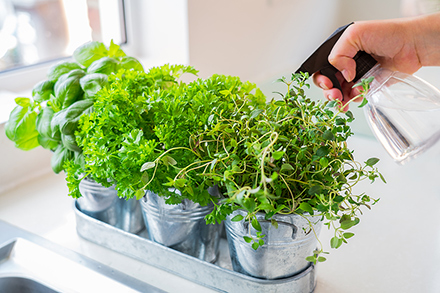How to grow your own food in an apartment

Are you a city slicker? If so, space might come at a premium. There are plenty of advantages to living in an apartment - in many cases, condominiums offer a tempting combination of an enviable location and luxurious specs. But if you are an apartment dweller, the joys of having a garden could be something of a distant dream. That's why it is important to make the most of the space that you have.
Apart from offering a spot for chill-out time, barbies, and a morning coffee, balconies give you the opportunity to grow your own food, but they aren't the only viable location within your apartment. Let's start at the beginning...
Getting set up
Before you begin growing vegetables in your apartment, you need the right apparatus. There is a wide range of options when it comes to containers, and the containers you choose will depend on what you want to grow. Plastic planters and pots are suitable for lettuce and herbs, as are larger wooden containers, which you could also use for root vegetables, bush tomatoes and broccoli. Looking for container ideas that are a little 'outside the box'? Large jars can be used for root vegetables, while you might want to consider a wheelbarrow as a container for a 'no dig' vegetable patch. It's bound to turn a few heads!
Apartment veggies
In the section above, we mentioned some vegetables which you could choose to grow, but to be honest, some veggies are simply more geared for apartment living. Why not get a kick from growing your own chillis? Chillis can be grown indoors on a window sill, they just need six hours of sunlight a day or more. All you require is a small pot to start with, gradually increasing size as your plant gets larger.
Then there is kale, recognised as a superfood due to its high vitamin A, C and K and mineral content. It can grow all year round, whether on your balcony or inside. Just water it regularly and ensure that it is getting direct sunlight. The type of kale you grow is down to choice, but dwarf kale - such as Dwarf Green or Blue Curled - can be ideal due to its relatively diminutive size.
And how about potatoes? From sweet to white varieties, all you need to start is an old potato that is sprouting - simply cut into chunks and lay sprout-side up under the soil. You'll need containers - such as a large pot or special potato growing sack - which are fairly deep, and a degree of patience, as potatoes can take up to two months to be ready. Bingo - enjoy all the mashed potato, fries and roasties you can handle.
Some parting tips
There are some other things you might want to consider as an apartment or indoor gardener. When it comes to the composition of your vegetable bed, aim for a 1:1:1 ratio consisting of potting soil, compost and coconut coir, which can help to manage moisture levels.
If you don't have a balcony and are struggling for sunlight space indoors, then consider LED grow lights coupled with an automatic timer to ensure that your vegetables are getting the light they need. You can program your lights for hassle-free growing.
And finally, don't give up. If your veggies don't turn out as you would have hoped that first time around, assess what went wrong, and go again!
If you are tussling with an apartment plan that incorporates a vegetable garden, why not take advantage of our creative interior design expertise? Call Jarvis Interiors on +61 412 398 313.
